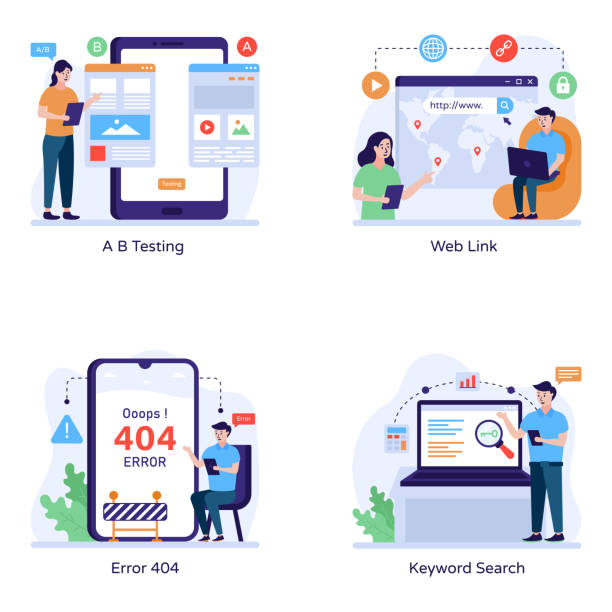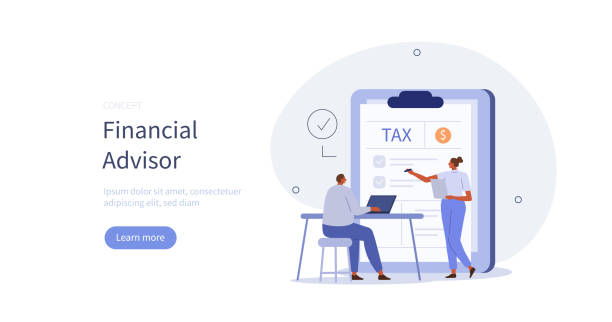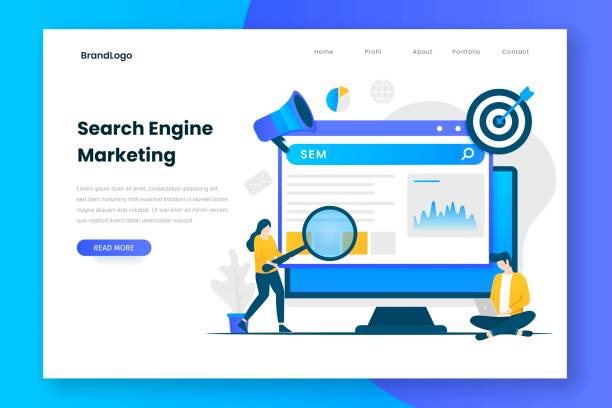Introduction to the Importance of Fast Website Design

In today’s digital world where speed is paramount, fast website design is more than an advantage, it’s a vital necessity.
Internet users don’t wait for long page loads, and if a website doesn’t load in a fraction of a second, they quickly abandon it.
This phenomenon is known as “bounce rate” and can severely damage your SEO and website credibility.
From an SEO perspective, search engines like Google consider website loading speed as one of the main ranking factors.
Therefore, a slow website not only provides a poor user experience (UX) but also significantly reduces your chances of being seen in search results.
In this #comprehensive and #specialized article, we will examine various aspects of #fast_website_design and provide practical solutions for #improving_your_website’s_performance.
Our goal is to equip you with sufficient knowledge to design or optimize a website that is both pleasant for users and highly valued by search engines.
This is an important educational step for any business that wants to make its mark in today’s competitive online space.
Do you have an online store but your sales are not as expected? Rasaweb solves your problem forever with professional e-commerce website design!
✅ Significant increase in conversion rates and sales
✅ Unparalleled user experience for your customers
⚡ Click to receive free consultation from Rasaweb!
The Impact of Website Speed on User Experience and SEO

Website loading speed is the backbone of an exceptional user experience (UX).
Imagine entering an online store and having to wait several minutes each time to view a new product; you would undoubtedly soon give up on shopping and go to another store.
Websites operate in precisely the same way.
Numerous studies have shown that even a one-second delay in page loading can lead to a significant decrease in Conversion Rate, an increase in Bounce Rate, and reduced user satisfaction.
This issue is particularly crucial in fast website design for online businesses and e-commerce.
From an SEO perspective, Google and other search engines are increasingly focusing on site speed.
Their ranking algorithms place faster websites higher in results because they believe these websites provide a better user experience.
Optimizing website speed means improving search result rankings, attracting more traffic, and ultimately, increasing sales and revenue.
This analysis shows that investing in website speed optimization is a smart and strategic investment for any business.
Key Factors Affecting Site Speed and Their Solutions

Fast website design requires identifying and addressing multiple factors that can affect its performance.
One of the most important factors is choosing suitable hosting.
Inexpensive shared hosting might suffice for small websites, but for high traffic or complex websites, cloud hosting or a dedicated server is recommended.
The size and dimensions of images and videos are also important factors.
Unoptimized images can severely reduce loading speed.
Using appropriate formats (like WebP), compression, and Lazy Loading of images is crucial.
Disorganized code, excessive JavaScript and CSS, and a high number of HTTP requests can also slow down the speed.
Code optimization, file compression, and using server-side and browser caching are among the specialized solutions to overcome these challenges.
Multiple WordPress plugins and content management systems, if not optimized or overused, can also cause site slowness.
| Slowdown Factor | Explanation | Optimization Solution |
|---|---|---|
| Inappropriate Hosting | Weak shared servers or far from users | Choosing quality hosting close to the audience, using CDN |
| Heavy Images and Media | Images with large dimensions or unoptimized formats | Compression, changing format to WebP, Lazy Loading |
| Inefficient Coding | Excessive and uncompressed CSS and JavaScript | Minification of codes, combining CSS/JS files |
| Lack of Caching | Every time content is fully loaded from the server | Activating browser cache and server-side cache |
| Too many HTTP requests | Each file (image, CSS, JS) creates a separate request | Spriting images, combining files, using CDN |
Advanced Techniques for Image and Media Optimization

In the context of fast website design, images and other media are often the main culprits for slow page loading.
A modern website without appealing visual content is unimaginable, but improper management of this content can be disastrous.
The first step in optimization is choosing the right format.
For opaque images, WebP format is often the best choice, as it offers similar quality to JPEG with a much smaller file size.
For transparent images, PNG can be suitable, but it should be compressed as much as possible.
Many online tools and WordPress plugins exist for image compression without noticeable quality loss.
Lazy Loading is an extremely effective technique where images and videos are only loaded when the user scrolls to the relevant section, not from the very beginning.
This significantly reduces the initial page load and provides a better user experience.
Also, pre-defining image dimensions in HTML prevents Layout Shift, which greatly aids the user’s visual experience.
Using SVG for logos and icons is also a very useful guided solution due to its vector nature and small size.
Are you worried that your company’s old website will drive away new customers? Rasaweb solves this problem with modern and efficient corporate website design.
✅ Increases your brand’s credibility.
✅ Helps attract targeted customers.
⚡ Contact Rasaweb for a free consultation!
The Crucial Role of Hosting and CDN Selection in Loading Speed

Choosing hosting and CDN (Content Delivery Network) are two fundamental factors in fast website design that are often overlooked.
Your hosting is the physical server that houses your website files.
The quality of hosting, including processor speed, memory, and server bandwidth, directly impacts the website’s responsiveness.
Inexpensive and shared hosts often have limited resources, which lead to slowness or even unavailability of the site during peak traffic.
For websites with medium to high traffic, dedicated hosting, cloud server or VPS is recommended.
CDN is also a network of servers that stores your website’s static content (such as images, CSS, JS) in different geographical locations.
When a user accesses your site from a specific region, the content is served to them from the closest CDN server, which reduces latency and significantly increases loading speed.
Using a CDN, especially for websites with global audiences or high traffic, is a specialized and extremely effective solution that remarkably improves user experience.
Optimizing Code and Scripts for More Speed

One of the important technical and educational aspects of fast website design is optimizing website coding and scripts.
Untidy code, large file sizes, and a high number of HTTP requests can severely reduce loading speed.
The first step is Minification of codes.
This process includes removing unnecessary characters such as spaces, newlines, and comments from CSS, JavaScript, and HTML files, which reduces file sizes.
The next step is Concatenation of CSS and JavaScript files.
Instead of the browser sending a separate request for each CSS or JS file, you can combine them into a larger file to reduce the number of HTTP requests.
Using Gzip compression for all files on the server is also essential.
Additionally, Asynchronous Loading or Deferring JavaScript scripts allows the browser to display HTML content before the scripts are fully loaded, which significantly improves the initial page render time.
These specialized techniques help you optimize the code structure of your site and significantly increase its loading speed.
Website Speed Testing and Monitoring Tools

To ensure that your fast website design is properly implemented and performs optimally, using speed testing and monitoring tools is essential.
These tools measure various metrics and identify your site’s weaknesses.
Google PageSpeed Insights is one of the most widely used tools, providing a score from 0 to 100 for both mobile and desktop and offering suggestions for improvement.
GTmetrix is another tool that provides more detailed information on loading time, page size, number of requests, and optimization recommendations.
Lighthouse, built into Chrome’s developer tools, offers a comprehensive report on performance, accessibility, best practices, SEO, and PWA.
WebPageTest also allows you to test your site from different geographical locations and with various browsers.
These educational and analytical tools not only help you measure your current site speed but also provide a roadmap for improving its performance.
Regular monitoring with these tools allows you to quickly detect and resolve any speed drops.
| Tool Name | Key Metrics | Distinguishing Feature |
|---|---|---|
| Google PageSpeed Insights | Core Web Vitals, First Contentful Paint, Largest Contentful Paint, Cumulative Layout Shift | Numerical scoring, Google’s recommendations for SEO improvement |
| GTmetrix | Performance Score, Structure Score, Total Blocking Time, Speed Index | Detailed waterfall reports, view performance across different browsers |
| WebPageTest | Load Time, First Byte Time, Start Render, Document Complete | Ability to test from various locations and devices, multiple tests |
| Lighthouse (Chrome DevTools) | Performance, Accessibility, Best Practices, SEO, PWA | Integrated with Chrome browser, comprehensive report on various aspects of the site |
Challenges and Solutions in Achieving Fast Website Design

Achieving fast website design is not always without challenges and often requires a questioning and analytical approach.
One of the common challenges is balancing speed and visual aesthetics.
Designers may be tempted to use high-quality images, multiple custom fonts, and heavy animations, each of which can lead to site slowness.
The solution is to consider optimization from the earliest stages of design and utilize techniques such as smart compression, lazy loading, and modern image formats.
Another challenge is the complexity of Content Management Systems (CMS) like WordPress and the large number of plugins.
Every installed plugin may add new JavaScript and CSS codes that reduce speed.
The solution is to use only essential and optimized plugins and regularly update them.
Also, a lack of developer awareness of best performance optimization practices is a challenge.
Educating and updating the technical knowledge of the development team is crucial for creating agile and high-speed websites.
This section, as a thought-provoking content, seeks to encourage deeper thinking about innovative solutions for website performance issues.
Did you know that poor online store design can drive away up to 70% of your potential customers? Rasaweb transforms your sales with professional and user-friendly e-commerce website design.
✅ Significant increase in sales and revenue
✅ Full optimization for search engines and mobile
⚡ [Receive free consultation from Rasaweb]
New Trends and the Future of Fast Website Design

The world of fast website design is constantly evolving, and new trends are emerging to increase speed and improve user experience.
One of the most important of these trends is Progressive Web Apps (PWA).
PWAs offer a combination of the best features of web and mobile applications; they load quickly, have offline capabilities, and can be installed on the user’s mobile home screen without needing to be downloaded from app stores.
This technology provides an unparalleled user experience.
Accelerated Mobile Pages (AMP) is also an open-source project from Google that aims to create extremely fast web pages for mobile devices.
AMP pages load almost instantly by removing unnecessary elements and optimizing code.
Other new and exciting trends include increased use of Server-Side Rendering (SSR) to improve initial content display time, and the emergence of HTTP/3 as the next generation of web protocols with better performance.
These innovations are pushing the future of the web towards greater speed and a smoother user experience, and web designers should pay special attention to these paths for fast website design.
Conclusion and Next Steps for Fast Website Design

Finally, we must emphasize that fast website design is no longer a luxury option but a fundamental pillar for the success of any website in today’s world.
From improving user experience to enhancing search engine rankings, website speed directly impacts your digital success.
In this article, we comprehensively and professionally explained the factors affecting speed, code optimization techniques, images, and infrastructure, as well as introducing monitoring tools and future trends.
Your next steps to ensure website speed optimization include the following: First, measure your current site speed with tools like Google PageSpeed Insights and GTmetrix.
Then, based on the reports from these tools, prioritize which sections need immediate improvement.
Image optimization, activating caching, using CDN, and code optimization are usually the best starting points.
Regularly monitor your site speed and ensure that speed does not decrease with content or plugin changes.
By implementing these recommendations, you will not only provide a better experience for your users but also significantly enhance your competitive position in the online space.
Frequently Asked Questions
| Question | Answer |
|---|---|
| What is fast website design? | The process of building websites that load quickly. |
| Why is website speed important? | It improves user experience, positively impacts SEO, and increases conversion rates. |
| What factors affect site loading speed? | Server speed, image size, code optimization, use of browser cache. |
| How can website speed be increased? | Optimizing images, compressing CSS and JavaScript files, using a CDN, and choosing suitable hosting. |
| What are common tools for testing site speed? | Google PageSpeed Insights, GTmetrix, Pingdom Tools. |
| Does the geographical location of the server affect speed? | Yes, less distance between the user and the server leads to less latency and faster speed. |
| What does image optimization mean? | Reducing the file size of images without significant loss of their quality. |
| What is browser cache and how does it help with speed? | Temporary storage of website resources (like images, CSS, and JS files) in the user’s browser for faster loading on subsequent visits. |
| What is the impact of site speed on SEO? | Google considers site speed as a ranking factor; faster sites usually achieve better rankings. |
| How can CSS and JavaScript files be optimized? | By minification and concatenation of files to reduce size and number of requests. |
And other services of Rasaweb Advertising Agency in the field of advertising
Smart SEO: An effective tool for campaign management with a content SEO strategy.
Smart Brand Identity: Designed for businesses seeking to increase sales through attractive UI design.
Smart Custom Software: A novel service to increase customer acquisition through the use of real data.
Smart Advertorial: A fast and efficient solution to increase website traffic with a focus on Google ad management.
Smart Digital Advertising: An effective tool to increase sales by optimizing key pages.
And over a hundred other services in the field of internet advertising, advertising consultation, and organizational solutions
Internet Advertising | Advertising Strategy | Advertorials
Resources
The Importance of Site Speed in User Experience
The Impact of Site Speed on SEO
Why Website Speed is Crucial for Your Business
Increasing Site Speed and Customer Satisfaction
? Do you dream of a powerful presence in the digital world? Rasaweb Digital Marketing Agency, with its expertise and experience, offers comprehensive and effective solutions for the growth and development of your business. From personal website design and corporate websites to SEO and advertising campaign management, we pave your path to digital success.
📍 Tehran, Mirdamad Street, next to Bank Markazi, Southern Kazeroun Alley, Ramin Alley, No. 6



